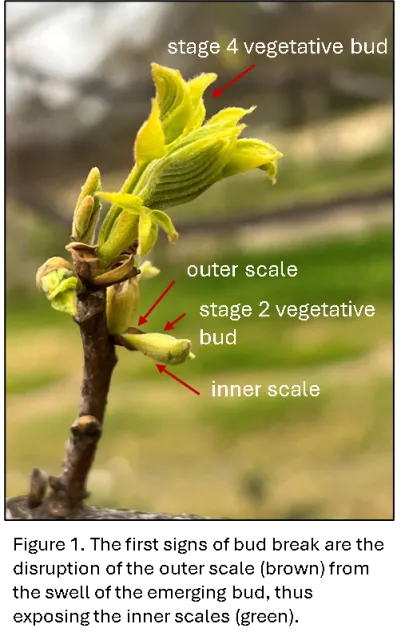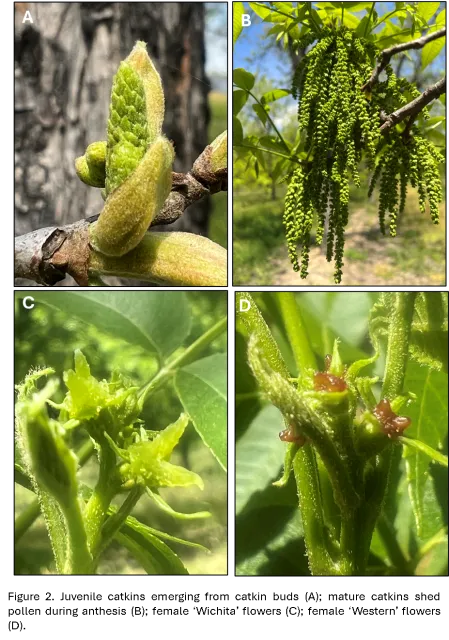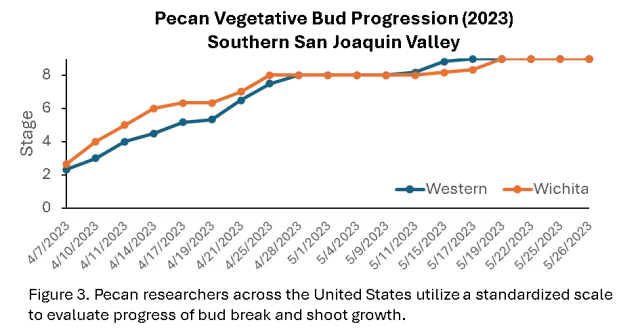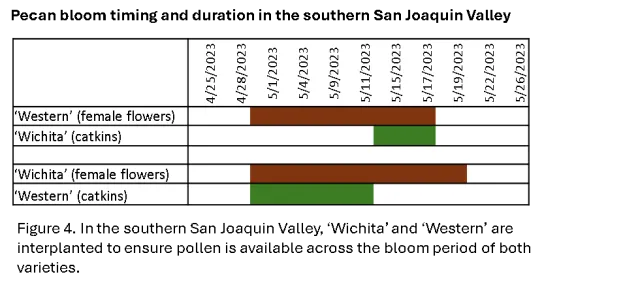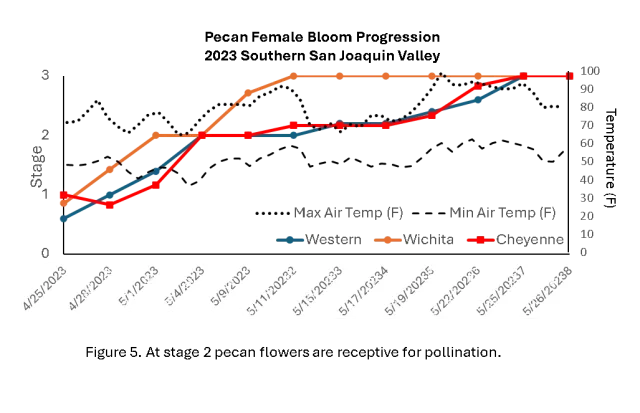Pecan bud break and bloom dynamics in the southern San Joaquin Valley
Pecan bud break and bloom dynamics in the southern San Joaquin Valley
Elizabeth J. Fichtner, Farm Advisor, UCCE Tulare County, Jennifer Randall, Professor, New Mexico State University, Richard Heerema, Extension Specialist, New Mexico State University
Of the four nut crops grown in California’s Central Valley, pecan tends to emerge from dormancy and progress into bloom the latest. Initial signs of vegetative growth are visible in early April (Figure 1), but bloom generally proceeds through the month of May, often exposing flowers to higher temperatures than the other nut crops.
Pecans and walnuts are in the same plant family (Juglandaceae), making their reproductive strategy very similar. Unlike February’s showy almond bloom, the pecan bloom is a more subtle event with pollination relying on wind rather than bees. They produce separate male and female flowers on the same tree, a term botanists call monoecious (Greek for ‘one house’). To promote outcrossing, the trees employ dichogamy, a strategy where the male (Figure 2A and 2B) and female flower parts (Figure 2C and 2D) do not mature concurrently for a particular cultivar. As a result, growers plant at least two cultivars of pecan in each orchard to ensure the overlap of female bloom with the availability of pollen to set a crop.
In the southern San Joaquin Valley, pecan orchards are generally composed of two cultivars, ‘Wichita’ and ‘Western’. In each orchard, the progression of bud break and shoot elongation varies between cultivars and with tree age (Figure 3). The first evidence of bud break is observed when the outer scales surrounding buds are disturbed revealing a set of inner scales that protect the vegetative buds (Figure 1) and male flower buds (catkins) (Figure 2A). Researchers across the pecan-growing regions of the United States employ a uniform scale (1-9) to evaluate bud break progression. This allows for breeders and horticulturists to evaluate the impacts of localized climate conditions on the phenotypic characteristics of cultivars utilized across the country. Stage 1 indicates dormant buds; stage 2 indicates bud swell with the outer scales split and inner scales intact (Figure 1). By stage 3 catkins may be present (Figure 2A) and the inner scales will have split. Stages 4 through 10 are the progressive stages of leaf burst, shoot elongation, and display of preformed leaves. In the southern San Joaquin Valley, the emergence from winter dormancy and early bud swell (stage 2) occurs at the onset of April, whereas leaf burst (stage 4) is observed in mid-April with vegetative growth on ‘Wichita’ preceding that of ‘Western’ (Figure 3).
The female flower buds are borne on the current season’s shoot; therefore, vegetative bud break and shoot elongation progress in advance of bloom. The female bloom of ‘Western’ and ‘Wichita’ overlap, and the cultivars can be differentiated by the color of the female flowers. The stigmas of the ‘Western’ flowers are a reddish-brown and the stigmas of ‘Wichita’ are a greenish-white (Figure 2C and D). In the southern San Joaquin Valley, the female flowers mature around the beginning of May (Figure 4). Similar to the rating of bud break and vegetative growth, researchers use a standardized scale to assess the progression of bloom across the United States. At stage 1, flowers have emerged; at stage 2 the female flowers are receptive for pollination. Once the female flowers progress to stage 3, stigmatic receptivity to pollen has passed (Figure 5). During female flower receptivity, maximum air temperatures may routinely range from 80-90°F. ‘Western’ catkins mature earlier than ‘Wichita’ catkins and can therefore serve as pollinizers for the earliest ‘Wichita’ female flowers (Figure 4). Similarly, ‘Wichita’ catkins mature later and can serve as pollinizers for the ‘Western’ female flowers.
By mid-late May the bloom season for pecan ends in the southern San Joaquin Valley. Growers can expect a late harvest of ‘Wichita’ and ‘Western’, generally around late October through early November. Wet weather, however, may push harvest later into December. ‘Pawnee’, an earlier maturing cultivar is more frequently grown in the Sacramento Valley, where harvest may be anticipated in late September through early October.
